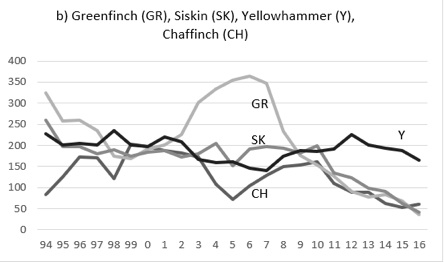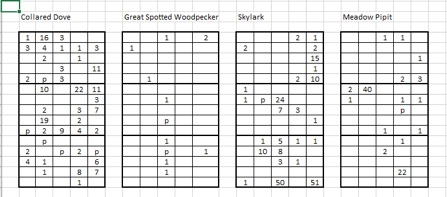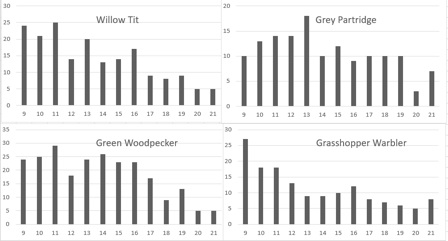Birds Near and Far
Home books dvds apps sites extra maps links contact us blog Buy
Birds Near and Far
Home books dvds apps sites extra maps links contact us blog Buy
A blog by Dave Gosney about some of the birds and places that feature in his books and DVDs but also about the state of birds in the Sheffield area

The State of Sheffield’s Birds
In recent years, and especially during the lockdowns, I’ve spent my time surveying parts of the Sheffield area. These studies have been written up and several of the papers have been published in the ‘2020’ volume of the Sorby Record (available here). Meanwhile here are some examples of what will appear in these papers.
Changes in numbers of breeding birds to the west of Sheffield (SK27, 28 and 29) since 1988-90
This paper shows the results of at least one 1-hour breeding season count in 74 of the 75 tetrads in this area and compares them with previous studies. Here’s one graphic from the paper; it shows that Yellowhammer used to be present in almost every tetrad in the area but is now found in only a few tetrads in SK27 and 29 and none at all in SK28.
Figure 8. The number of tetrads in which Yellowhammers were located in SK27, 28 and 29 during different surveys since 1975.
Changes in numbers of breeding birds to the east of Sheffield (SK47, 48 and 49) since 1988-90
This paper shows the results of 1-hour counts in every tetrad in these three 10km squares down the east side of Sheffield and compares them with previous studies. Here’s a sample, highlighting the species that are still present but have declined in number since 1988-90. Note how many species have declined by over 80%.
Figure 4. Species showing a decrease in number of over 30% in SK47-49 since 1988-90
Species Number counted % decrease
1988-90 2021
Redshank 28 1 -96%
Willow Tit 27 2 -93%
Meadow Pipit 79 7 -91%
Lesser Redpoll 10 1 -90%
Tree Sparrow 114 13 -89%
Grey Partridge 78 9 -88%
Lapwing 534 64 -88%
Treecreeper 16 2 -88%
House Martin 379 76 -80%
Swift 813 193 -76%
L Ringed Plover 12 3 -75%
Yellowhammer 475 136 -71%
Sedge Warbler 41 14 -66%
Little Grebe 8 3 -63%
Mistle Thrush 133 55 -59%
Black-headed Gull 318 133 -58%
Willow Warbler 407 190 -53%
Swallow 400 191 -52%
Yellow Wagtail 16 8 -50%
House Sparrow 1524 874 -43%
Moorhen 115 69 -40%
Kestrel 49 30 -39%
Starling 1176 809 -31%
Have winter flocking birds become less numerous to the east of Sheffield (SK47, 48 and 49)
This paper analyses the published records of flocking birds in the Sheffield Bird Reports since 1973 to look for changes in bird numbers. Here is one of the graphics; it shows that flocks of some species have recently been getting smaller, especially since 2010.
Figure 5 Sum of the best 3 winter counts to the east of Sheffield (SK47-49) each year since 1994 (expressed as 5-year rolling mean): species showing recent declines
A survey of the numbers of birds wintering to the east of Sheffield (SK47, 48 and 49) in 2020/21 and 2021/22
This paper shows the results of 1-hour counts in winter in every tetrad in these three 10km squares down the east side of Sheffield and compares them with previous studies. Here are maps for a few of the species (sorry, the boundaries of the 10km squares have been lost in the formatting here): note that Collared Dove is far from ubiquitous and the other three species were missing from large parts of the area. Note also the importance of a few ‘hotspots’ for Skylark.
Bird numbers on the suburban edge of Sheffield – a study of eight tetrads around Stannington in 2021
In lockdown I had to do my birdwatching within walking distance so I carried out 16 1-hour counts over the year in each of the eight tetrads closest to my home. Here’s some of the text describing what I found
Back in 1975-76 when the author carried out a Common Birds Census in Little Matlock Wood, the species present in the breeding season included Woodcock, Cuckoo, Little Owl, Green Woodpecker, Tree Pipit, Redstart, Garden Warbler, Wood Warbler (2 pairs), Spotted Flycatcher, Willow Tit (2 pairs), Tree Sparrow (3 pairs), Redpoll, Hawfinch (one singing but on one date only) and Yellowhammer (2 pairs). None of those 14 species still breed in this tetrad; that’s 14 of the 47 species recorded in the wood in 1975-76 that have now gone. That’s not counting the Grey Partridge, Lapwing, Swallow and Yellow Wagtail which used to be found in the fields nearby. Another significant change is the loss of what was then 16 pairs of Willow Warbler in the wood; now there are none, although one singing bird was recorded elsewhere in the tetrad in 2021.
Charting the decline of selected bird species to the east of Sheffield (SK47, 48 and 49)
This paper is an analysis of the archive of records held by the Sheffield Bird Study Group, looking at changes in numbers in SK47, 48 and 49 since 2009. Here’s one of the many graphics:
It shows the number of sites from which breeding season records were received in each year since 2009



